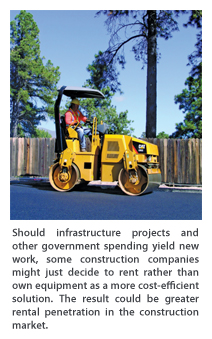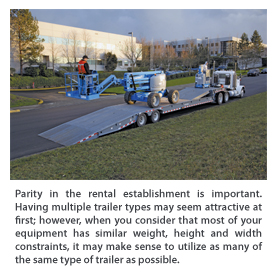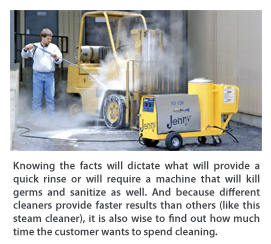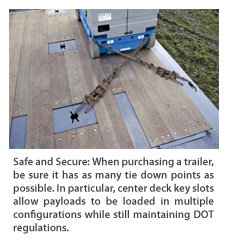Rental Focus

![]()
 If you are looking to improve your business’s bottom line, consider renting the right equipment for your project. When dealing with a reputable provider, renting can give you all of the advantages of having a premium piece of equipment, without the costs or responsibilities of ownership. When a machine needs service or repairs, they do it for you. You’ll never have to worry about how to dispose of the unit at the end of its usable life. Also, a wide assortment of reliable rental equipment can be delivered to your jobsite quickly, giving you convenient access to the right equipment for almost any task.
If you are looking to improve your business’s bottom line, consider renting the right equipment for your project. When dealing with a reputable provider, renting can give you all of the advantages of having a premium piece of equipment, without the costs or responsibilities of ownership. When a machine needs service or repairs, they do it for you. You’ll never have to worry about how to dispose of the unit at the end of its usable life. Also, a wide assortment of reliable rental equipment can be delivered to your jobsite quickly, giving you convenient access to the right equipment for almost any task.
Benefits of Renting
Rental houses allow contractors the ability to get equipment on short notice without the inconvenience and cost of having to transport the equipment to the jobsite. Some contractors will rent because it simply takes away the hassle of scheduling what is needed from their own fleet on the jobsite. It’s one less thing they have to think about.
Since customers often rent equipment for long-term needs, it is important to find a vendor who schedules and performs many preventive maintenance updates at the jobsite and ensures the reliability of its equipment. Look for disciplined maintenance programs that result in higher customer utilization of equipment, meaning greater overall productivity.
Rental equipment companies have taken the industry beyond just machinery, adding benefits that exceed the cost. For example, Mobile Tool Rooms from RSC Equipment Rental are portable trailers custom stocked with the specialized tools and small equipment used for a short-term project. Onsite maintenance prevents costly downtime and increases productivity. Some companies offer a proprietary software program, which allows the customer to more efficiently manage its fleet, costs, time and rental spending — all issues that are of particular importance on long-term projects with large jobsites. Safety comes first in the rental equipment industry, with programs designed to raise the bar in the industry and help companies manage a safer operation.
How Renting Affects the Bottom Line
In our current economic environment, most companies are looking for ways to cut back and minimize expenses. Fewer companies are willing to spend the necessary amount of money to expand their fleet or purchase new equipment, especially when older, less reliable machines are still part of their overhead. As emissions standards become stricter and fuel costs rise, renting equipment seems like a viable option for those dealing with financially insecure situations, especially when companies are not interested in making a large investment in a machine that has the potential to sit idle for months on end.
“Renting is a great option for those who may need a specific piece of equipment for one phase of a project but don’t foresee getting that much use out of the equipment in the long run,” says Erik Olsson, president and CEO of RSC Equipment Rental. “Even in cases when they think they may use it frequently, it’s worth comparing the cost of renting vs. owning the equipment. I think most contractors would be surprised at how much they can save. The decision to own vs. rent should be analyzed over the useful life of an asset, and the percent of time that asset will be utilized is a critical component.”
The Debate Continues
The most important thing to remember when deciding whether to rent or own is that there are options. Buying allows companies the convenience of already owning the equipment. Renting allows companies to control their expenses and conserve capital while still getting top-quality equipment that is well maintained and safe — an option that in the current economic situation may be the better decision.
Per Ohstrom is the vice president of marketing at RSC Equipment Rental Inc., based in Scottsdale, Ariz.

“Sometimes we need a piece of equipment for a limited period of time,” says Southards, the equipment manager at the ICON paving company. “We don’t want to make a financial commitment to that machine, and then have to turn around and sell it when we’re done with it. Or, worse yet, we don’t want to use it for a few weeks and then have it sit for months. There are situations when renting is the best financial alternative.”
Southards’ company continues to purchase new equipment, but he and others at ICON make sure the machine will be required for an extended period.
“This year, I had four crews,” Southards says. “On some jobs, we needed extra rollers. But that wasn’t always going to be the case, so we rented what we needed. That kept the crews productive, but we could return the extra machines when the work was done.”
ICON rented between 70 to 75 pieces of equipment last year. That included larger machines, like excavators and track-type tractors, and smaller pieces of equipment such as generators, pumps and plate compactors. “I get what I need,” Southards says. “I can get equipment with low hours; sometimes it’s brand new.”
10 Key Benefits to Renting
- No capital investment. Renting frees up your business’ capital. An expense is only incurred for equipment needed — and only as long as you need it — on a particular job.
- No financing hassles. It’s typically easier to qualify for a rental than a purchase. Check to see how you can get the equipment you need.
- Increase your borrowing power. Renting equipment does not appear as a liability on your balance sheet.
- No equipment obsolescence. Renting allows you to use the latest technology without costly depreciation.
- No maintenance worries. That means you can eliminate costly service shops, service tooling, spare parts and cumbersome maintenance records.
- Eliminate storage costs. What’s more frustrating than paying for equipment you don’t use? Paying to store that equipment. You avoid that cost when you rent. Call for a quick pickup, or simply drop off the equipment when you’re finished.
- Responsive service. Make sure the dealership has what you need. They’re only a phone call away.
- Try it before you buy it. Rent a key piece of equipment to help you evaluate a potential purchase while completing a profitable job.
- Supplement your fleet. Rental lots can supply the equipment and work tools you don’t regularly need.
- Minimize costly breakdowns. Fleets are loaded with new, reliable equipment that is put through a rigorous testing process, so you can depend on it to get your job done on time.
This article is courtesy of Caterpillar Paving Products’ Paving News, based in Minneapolis.

It may seem as though the only thing on your fleet manager’s mind when he chose your current trailer was that day’s lunch menu. Therein lies the challenge. The driver and the fleet manager have different expectations from the same piece of equipment. While a fleet manager asks: “How do I make this trailer pay for itself?” The driver asks: “How do I get the most deliveries out of my rental trailer with the least amount of down time?”
With some understanding of what works best for both your driver and your fleet manager, it’s possible to pick the best trailer for your rental fleet. Here are some guidelines to assist you in keeping the peace with your drivers and your bottom line.
Safety Is of Prime Importance
We all know that safety is important for your staff and your equipment, but have you considered the safety aspects of your trailers? Payload distribution is an important consideration. Pick a trailer that has at least a 70,000-lb distributed payload rating. This will help your trailer manage the smallest scissor lift to large booms with ease.
Tie downs offer the driver several options when securing a load for delivery. When purchasing a trailer, be sure it has as many tie down points as possible. In particular, center deck key slots allow payloads to be loaded in multiple configurations while still maintaining DOT regulations.
Maximize Value Through Proper Maintenance
Realize the most out of your trailer investment. Careful consideration of maintenance, both before and after the purchase, is important. Pay attention to how trailers are built. You may want to consider purchasing a service warranty contract.
Grease fittings are one of the most overlooked items on trailers. Picking a trailer that has accessible grease fittings on flip tail hinges can help extend the trailers’ service life and prevent expensive repairs. Hydraulic filter systems keep fluids from being contaminated. Choosing a trailer with inline filtration is one of the ways of avoiding expensive downtime repairs.
 The Ultimate Essential: Ease-of-Use
The Ultimate Essential: Ease-of-Use
Ease-of-use equates to efficiency and cost effectiveness. Here are some basic elements to consider:
- Maneuverability is paramount when making deliveries inside city limits and tight construction sites. Choosing a trailer with a shorter wheel base design allows the driver to get in and out of tight places reducing the risk of damage and may reduce delivery times.
- Remote winch controls are not a luxury. The ability to control a winched load from a safe distance can provide a higher level of safety and may reduce delivery cycle times. Some trailer manufacturers even offer wireless remote controls that allow the operator to drive equipment and control the winch simultaneously.
- Many flip tail trailers have light indicators for hydraulic controls. The light indicators offer the driver visual confirmation when the flip tail locks are engaged.
- Flip tail trailers offer a great way to simplify loading and unloading from both ground level and dock deliveries. Flip tail trailers are typically more convenient than sliding axle trailers because they require less maintenance and offer more flexibility when lifting a non-operable piece of equipment. The key is to choose a trailer with a low break-over point between the main deck and the tail. The lower break-over angle provides the ability to load equipment with low ground clearance.
Standardization
Having multiple trailer types in your lineup may seem attractive at first, however, when you consider that most of your equipment has similar weight, height and width constraints, it may make sense to utilize as many of the same type of trailer as possible.
Choosing a standard trailer configuration allows interchangeability for driver usage, parts ordering and service requirements. In addition, your customer and potential customers will soon be able to recognize your brand color and profile of your trailer rolling into their next jobsite.
Remember, choosing a trailer should not be an afterthought for your rental operation. After all, your rental equipment can’t generate revenue if it’s sitting in your yard, or even worse, loaded on a trailer that’s broken down on the highway. Drivers and fleet managers basically want the same thing: Deliver equipment quickly, safely and cost-effectively. Paying attention to trailer safety, maintenance, ease-of-use and standardization can provide rewards in the way of happy drivers and bigger operating earnings.
Tim Maxson is the plant director at Terex Load King, based in Elk Point, S.D.

There are several products available to assist in cleaning efforts. While this can be great for your rental operation, in the sense that it will allow you to provide many helpful options to assist a customer’s cleaning efforts, it can also be overwhelming for the customer to choose the right one. It is up to you to have the knowledge and expertise to recommend the best solution for each individual problem, likely resulting in a happier, repeat customer.
Ready, Set, Clean!
It is a busy day at the rental center and there are several customers with varied cleaning needs. Let’s examine a few possible situations and take a look at which machine would be the best solution to each problem.
The first customer of the day has a fairly simple need. His deck and patio furniture are a bit dirty and he needs something that will wash away the dirt, leaves and other debris. Knowing the contaminate and the fact that he is looking for a quick surface clean, one would first want to recommend a cold pressure washer.
These machines work great when used for the proper applications. Relying on high flow and water pressure, the cold washers are not able to heat the water, so they are best suited for quick surface cleaning and tasks such as spraying mud or dirt off vehicles, lawn furniture, wooden decks or sidewalks. Certain chemicals can also be incorporated with the use of a cold pressure washer if desired.
While the solution in this scenario appears fairly obvious, one may also want to let the customer know that a hot pressure washer would provide a quicker and more thorough clean. Using the same high flow and water pressure as a cold washer, the hot washer also incorporates high temperatures. Any time that temperature is increased in a cleaning situation, the results will always be better.
This customer decides a cold pressure washer will suit his needs just fine, but the man browsing nearby has overheard the conversation and wonders if a hot pressure washer would be the best solution to his problem. He is a farmer and needs to clean heavy dirt and grime off some equipment. Because grime clings to or imbeds in surfaces, it requires more than just high water pressure to remove it. Adding chemical and increasing temperature will effectively loosen the grime and clean it away.
For this customer, a hot pressure washer would indeed be the best choice. Other great uses for hot pressure washers include cleaning large areas more quickly than a cold pressure washer, removing gum from sidewalks and cleaning engines and automotive parts.
The next customer of the day owns a small restaurant and needs a heavy-duty cleaning machine for the greasy messes in the kitchen, particularly a machine that will also kill germs and sanitize. While one may be quick to recommend a hot pressure washer, this would be a mistake. Although hot washers can remove grease to some extent, the high water pressure will end up spattering most of the contaminate around and often will leave a film behind. For this customer, a steam cleaner would be the best recommendation.
The term “steam cleaner” is really a misnomer since the machine doesn’t actually use steam to clean. Steam cleaners utilize vapor that is made up of 85 to 90 percent water and are very effective at removing grease, oil, animal, vegetable and mineral contaminates. They are also excellent at killing germs and sanitizing. Chemicals may be incorporated to make the cleaning process faster and more effective. And as an added bonus, steam cleaners use less water than other machines, which is important for areas where flooding may be a concern, like in this case with a restaurant kitchen.
A common misconception many people have is that because 212 degrees Fahrenheit is the atmospheric boiling point for water, it must be a hot enough temperature for the water in a steam cleaner. However, the environment created inside a steam cleaner allows the water to be heated to more than 212 degrees without boiling. This is why water temperatures for these machines actually range from 300 to 335 degrees Fahrenheit and they are most effective when the temperature is 325 degrees Fahrenheit.
As the day progresses on, customers are leaving the store satisfied and eager to tackle their cleaning problems. The day is winding down, and one more customer walks through the door, appearing a bit panicked. He explains that tomorrow marks the beginning of the annual spring cleaning at her home and she has a long list of cleaning tasks. These include cleaning out his pool, washing the four family vehicles and removing several tough contaminates such as honey, tar and glue.
Hmmm…well, the cold and hot washers would work well for the pool and vehicles, but what about the honey, tar and glue? For that task, a steam cleaner would be the only choice because its high temperature will melt away the contaminates. But a steam cleaner isn’t the best machine to accomplish the other tasks, so what is the best advice? Rather than suggest all three machines, this is the perfect situation where one could promote the benefits of a combination cleaner.
Combination cleaners consist of both a cold and hot pressure washer, as well as a steam cleaner, in one portable package. Because they offer the option to quickly switch between the three functions, the two biggest features they offer are convenience and versatility. They save the user time, as well as spare them the need to rent multiple machines.
While versatility is the main selling point of these machines, it can also be overkill for the customer. They may see the machine as a time-saver and an opportunity to have one cleaner that can do it all, but in reality they may not need all three uses, resulting in wasted functionality. So, again, be sure to clarify each customer’s intentions before simply renting a catch-all solution. Though it takes a little extra time, renting a more catered solution helps build stronger, longer-term relationships with customers.
People clean to achieve a variety of results. Whether they are prepping surfaces for painting, killing germs and sanitizing or simply cleaning for appearance sake, it is important to remember that there will always be one combination of the basic cleaning elements that produces the best results. Armed with this knowledge, you’ll now be able to better analyze customers’ challenges and provide them with the proper tools and information to make the best cleaning decision.
Dan Leiss is the president of Jenny Products Inc., based in Somerset, Penn.

 The Ultimate Essential: Ease-of-Use
The Ultimate Essential: Ease-of-Use
Comments are closed here.